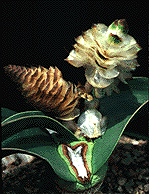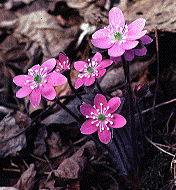There are two types of vascular tissue:
2. Phloem - move sugars and other dissolved nutrients from sites of photosynthesis to other parts of the plant. Consists of cellulose reinforced living cells.
Provide skeletal support and a circulatory system of body. Allows body to get larger.
1. Seedless Vascular Plants
Earliest Vascular Plants
Vascular plants first appear in the fossil record during the mid-Silurian period, about 410 million years ago. These had no leaves or roots; instead they had green photosynthetic stems which served as both anchors in the ground and photosynthetic surface. The tips of the branches had a spore case (called a sporangia):
Fossil |
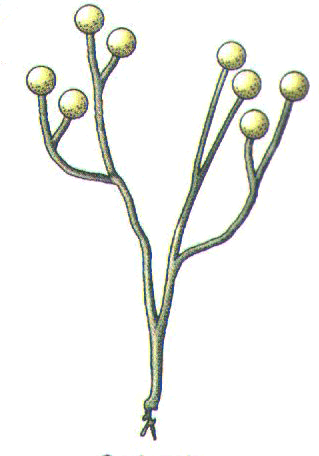 |
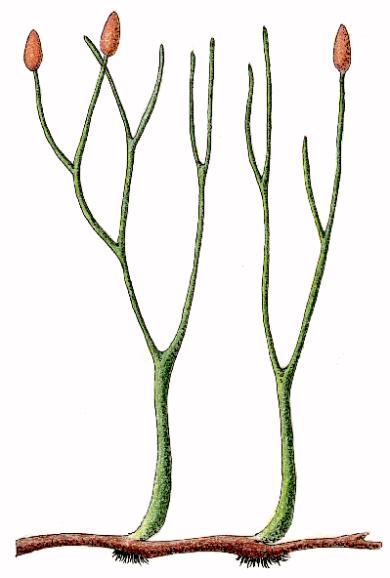 |
These simple plants tended to be crowded into the moist habitats surrounding bodies of water (some may actually have been aquatic, with their underground stems in shallow water), competition for light was a major factor in their evolution over time they increased in size and the complexity of branching:
In the middle of the Devonian, some of these developed small flaps of photosynthetic tissue (enations) that covered the branches. These flaps of tissue could increase the area over which gas-exchange and photosynthesis could occur:
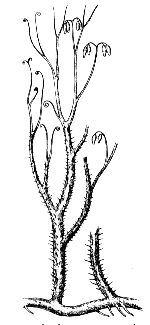
| Living species are all put in the phylum Psilophyta (whisk ferns - not true ferns): |  |
Life cycle:
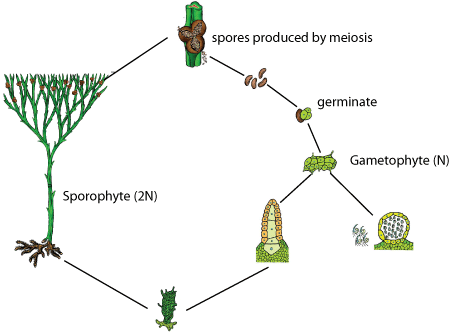
Lycopods:
Lycophytes are the oldest group of vascular plants that has living members. They dominated major habitats for 40 million years about 400 million years ago in the paleozoic. The lycophytes are a small and inconspicuous group of plants today, but during the Carboniderous they were forest-forming trees more than 35 meters tall.
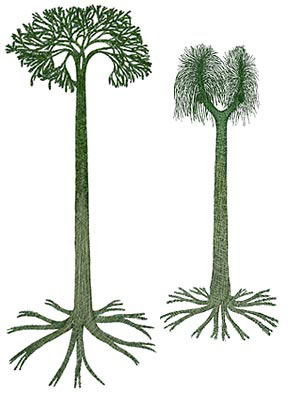
One modern group, the club mosses, are usually evergreen and have been used as Christmas
decorations, though their flammable spores and increasing rarity has made this
illegal in some states.
The most significant feature of lycophytes are microphylls - a flattened thin leaf with only a single unbranched strand of vascular tissue, or vein. The thin stem would have been better suited for photosynthesis and gas exchange than a photosynthetic stem. This microphyll is the first leaf (in other land plants leaves have multiple veins, usually branching one or more times within the leaf). These leaves are believed to have evolved from the enations of earlier plants (see above):

In the lycophytes, special leaves called sporophylls produce a sporangium.
While many lycophytes have their sporophylls scattered along their stem, most
produce them in a strobilus, a cone-like structure consisting of many spore
producing leaves growing together in a tight cluster.
These producing two kinds of spore, each of which will give rise to a single-sex
gametophyte:
Ferns:
The Sporangia that produce the dustlike haploid spores. Several sporangia grouped together are called a Sorus. The arrangement of sporangia varies greatly in ferns. Most ferns that we would see as we walk through the forest would have their sporangia on the underside of the leaf.
Fern Life Cycle: Spores from the parent fall to the ground and with an enormous amount of luck (millions perish for every success) they will find suitable moisture and light. The tiny single-celled organism starts to grow by cell division and forms a little green heart shaped plants or gametophytes. These plants go unnoticed by most people as they are only 1/2 inch or less across and lie flat on the ground. This is an independent plant with its own simple "root" system (rhizoids) to provide it with nutrients and water.
The gametophyte then grows male organs and female organs on its underside. The sperm will swim via a droplet of water to the egg. The fertilized egg then begins to grow the Sporophyte, the plant that we know as a fern.
2. Seed Plants
Protection of sperm in pollen and young in a seed first appears in plants during the late Devonian.
Seeds develop from a fertilized egg (or ovule) and consist of an embryo, nutrient, protective coating:
Pollination - the tranfer of pollen to the ovule (this is analogous to sperm brought to the egg) for fertilization without water.
The oldest known seed plants are called "seed ferns". This name is misleading since the they are not ferns at all despite the superficial similarity of their leaves to those of ferns. Seed ferns are entirely extinct. The earliest were vine-like plants, probably less than two meters tall, that probably grew epiphytically on other plants for structural support. Later forms were tree-like:
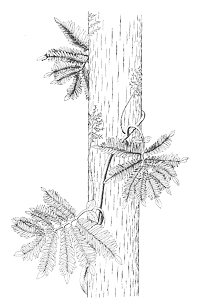 |
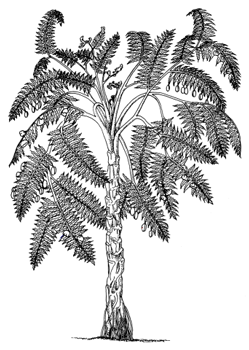 |
In seed ferns, seeds were produced singly or in pairs, and were surrounded by a small cup-like structure producing a somewhat sheltered chamber at one end of the seed. Within this cup, the seed was enclosed by a more tighly appressed tissue called the integument . The integument is a layer of tissue found in all seeds. It is produced by the parent plant, and develops into the seed coat. An opening was left at one end, which permitted pollen to enter and provide sperm to fertilize the egg cell. Both the integuments and cupule are believed to have evolved from reduced and fused branches or leaves. |
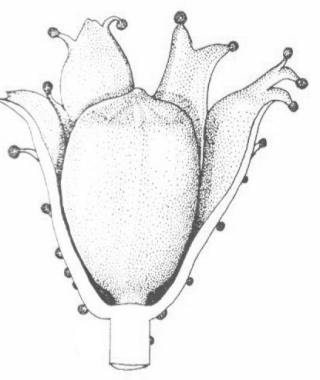 |
In later seed plants, a small pollen chamber appears just inside the opening. In modern cycads and conifers, this chamber exudes sticky fluids to aid in pollen capture, and as the fluid dries, it pulls the pollen inside the micropyle.
Cycads: The nine or ten genera and perhaps 100 species of cycads living today represent the remnants of a once large group that first appeared in the fossil record during the carboniferous.
They became dominate during the mesozoic and formed a large part of the diet of some herbivorous dinosaurs.
The sporophyte of the cycad is the large and in modern cycads resembles palm trees but have a large stobilus (or cone) at the apex of the trunk. These cones contain either the male gametophyte (which produces pollen) or the female gametophyte (which contains the egg and where the seed is formed).
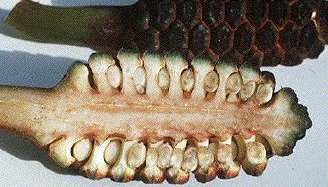
During the Middle Jurassic there was a great increase in species with a maximum diversity during the Cretaceous period (144 million years ago) in areas now known as Asia, Europe and North America.
Due to geological cataclysms at the end of the Cretaceous there are only two species were left (Ginkgo adiantoides and Ginkgo gardneri). The extinction of the dinosaurs and large reptiles as important seed dispersers of the large seeds may also have influenced this decline.
About 7 million years ago the Ginkgo disappeared from the fossil record of North America. It was gone from Europe by about 2.5 million years ago. It was thought to have gone extinct until rediscovered in China. Today used as ornamental and medicinal plant.
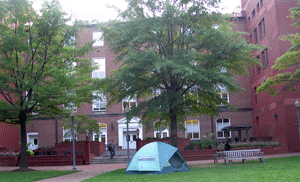 |
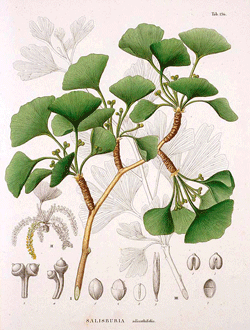 |
Conifers: familiar cone-bearing plants pines, firs, etc.
The leaves of conifers are modified into needles.
Gnentales: small group that is probably most closely related to flowering plants.
An interesting feature of all gnetophytes is the presence of both tracheids and vessel elements in their xylem tissue. Most flowering plants contain vessel elements, too, providing evidence to some botanists that the Gnetophyta might have been ancestral to angiosperms.
